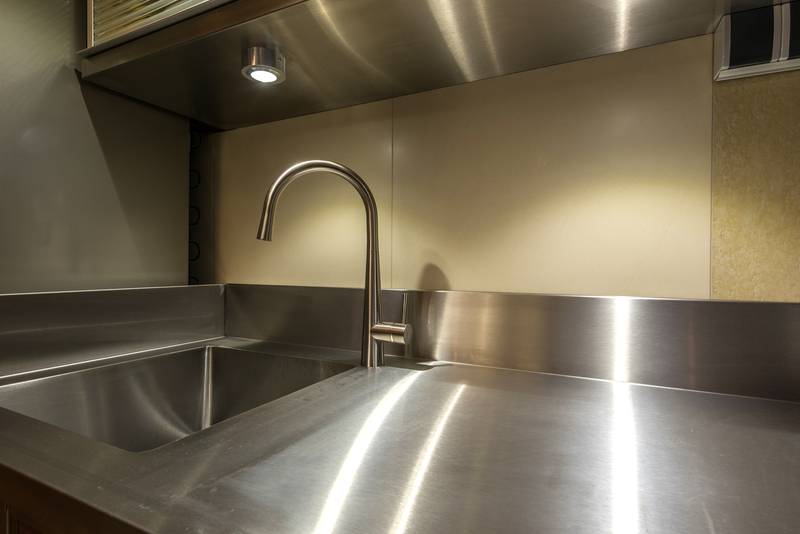Conquer Persistent Damp Odors with Simple Tips
Posted on 03/07/2025
Conquer Persistent Damp Odors with Simple Tips
If you have ever encountered a musty, damp, or mildew-like smell lingering in your home, you know that persistent damp odors can be as unpleasant as they are stubborn. Not only are these odors unsavory, but they can also signal underlying moisture issues that can impact your home's structure and your health. In this comprehensive guide, we'll explore tested and effective strategies to eliminate damp smells for good using simple, actionable tips. Whether it's a dank basement, a stuffy closet, or a perpetually humid bathroom, you'll find solutions here!

Understanding Persistent Damp Odors: Why It Happens
Before we tackle eliminating musty and damp odors, it's vital to understand what causes them in the first place. Persistent damp smells usually originate from:
- Excess moisture in the air or trapped in soft materials like carpets or upholsteries.
- Poor ventilation in areas like basements, crawl spaces, or bathrooms.
- Mold and mildew growth on surfaces or within walls.
- Leaks in plumbing, roofing, or windows leading to water damage.
- Condensation on cold surfaces, especially in high-humidity seasons.
Left unchecked, these issues can not only produce recurring damp odors but also damage property and trigger health problems like allergies and respiratory complaints.
Key Principles to Remove Musty Smells from Your Home
To successfully conquer persistent damp odors, remember these cornerstones:
- Identify and fix the source of the moisture.
- Thoroughly clean and dry affected areas.
- Neutralize and deodorize odors safely and naturally.
- Prevent future problems with ongoing maintenance and controls.
Now, let's dive deeper into each step to ensure you can effectively eliminate that unwanted damp odor, regardless of your situation.
Step 1: Track Down the Source of Moisture
Common Hotspots for Damp Odors
- Basements and crawl spaces
- Bathrooms, laundries, and kitchens
- Attics and under-eaves spaces
- Closets and wardrobes
- Rooms with recent plumbing leaks or flooding
Use your senses to pinpoint the problem:
- Look for damp patches, yellowing paint, water stains, or peeling wallpaper.
- Feel for soft or spongy walls, floors, or ceilings.
- Sniff for the source--move items or lift corners of carpets to locate intense odors.
Common Moisture Sources to Investigate
- Plumbing leaks: under sinks, behind appliances, inside walls
- Roof leaks: water stains on ceilings or in attics
- Poor drainage: water pooling against your home's foundation
- Inadequate ventilation: windows that are rarely opened or blocked vents
- Condensation: on windows, pipes, or cold walls
Step 2: Dry Out and Ventilate the Area
*Effective moisture control* is essential for eradicating damp odors and preventing mold. Here's how to dry out problem areas:
- Open windows and doors to let fresh air circulate wherever possible.
- Use fans and dehumidifiers to remove moisture from the air and speed up drying.
- Utilize moisture absorbers like silica gel, baking soda, or charcoal in enclosed spaces.
- Hang damp rugs, clothes, or curtains outdoors to dry in sunlight whenever feasible.
- Repair leaks promptly to prevent further moisture build-up.
*Pro tip*: A dehumidifier is particularly effective in basements and bathrooms with persistent damp smells. Set the humidistat between 40-50% for optimal results.
Step 3: Deep Clean Surfaces and Materials
Even after the source of moisture is addressed, fabrics, carpets, and surfaces can absorb lingering musty odors. Deep cleaning is your next line of defense.
Cleaning Hard Surfaces
- Mix a cleaning solution: Combine one cup of white vinegar with one gallon of warm water.
- Thoroughly wipe down affected walls, floors, and tiles with a sponge soaked in the solution.
- For mold: Use a dedicated mold remover or a mixture of hydrogen peroxide (3%) and water. Scrub with a brush. Wear gloves and ventilate well!
- Rinse and dry: Towel-dry surfaces or use a fan after cleaning.
Cleaning Fabrics, Upholstery, and Carpets
- Launder washable fabrics (curtains, cushion covers, bedding) with an extra rinse cycle and add one cup of white vinegar to eliminate trapped odors.
- Steam clean carpets and large upholstery or hire professionals if smells persist.
- Sprinkle baking soda liberally on carpets and leave overnight. Vacuum thoroughly the next day to freshen underfoot fabrics.
- For non-washable fabrics: Mist lightly with a mix of water, white vinegar, and a few drops of essential oil. Air them out as much as possible.
Step 4: Neutralize and Deodorize the Air
Natural Odor Absorbers to the Rescue
- Baking Soda: Place open boxes or bowls in closets, cabinets, or corners to absorb lingering smells from the air.
- Activated Charcoal: Use sachets or bags designed for home use--excellent in musty storage areas, basements, or attics.
- White Vinegar: Fill shallow dishes and leave them overnight to neutralize odors in rooms with persistent damp odor.
Enhance with Natural Fragrance
- Simmer citrus peels and spices (like cloves or cinnamon) on the stove to freshen your home quickly.
- Use essential oils such as tea tree, eucalyptus, lavender, or lemon in diffusers for a clean, uplifting scent.
- Indoor plants like aloe vera or peace lilies can also help purify the air and impart a fresher feel to your space.
Remember to avoid masking odors with synthetic air fresheners, which often just cover up the issue without addressing the source.
Step 5: Prevent Future Damp Smell Issues
The best way to conquer persistent damp odors permanently is to prevent them from recurring. Take these ongoing steps to keep your home fresh:
- Install and regularly use extractor fans in bathrooms and kitchens to remove excess humidity.
- Insulate and ventilate crawl spaces, attics, and basements to reduce condensation and mildew growth.
- Fix leaks immediately--a dripping pipe or roof can quickly escalate into an odor and mold problem.
- Maintain gutters and outside drains to direct water away from your home's foundation.
- Store seldom-used items in airtight containers with moisture absorbers inside outbuildings or closets.
- Open windows regularly--even 10 minutes a day can make a difference in air quality.
- Monitor humidity levels with affordable hygrometers; keep levels under 60% whenever possible.
Room-by-Room Guide: Removing Damp Odors from Specific Areas
Banish Basement Mustiness
- Invest in a powerful dehumidifier and run year-round if necessary.
- Seal foundation cracks and repair leaks promptly.
- Store items off the floor on shelves to allow air movement.
Freshen Up Your Bathroom
- Wipe down tiles and grout regularly with anti-mildew cleaners.
- Keep a squeegee handy for shower walls and doors.
- Leave the bathroom door open after bathing to enhance airflow.
Beat Bedroom and Closet Odors
- Rotate and air out bedding, linens, and clothing often.
- Use breathable storage bags or boxes for out-of-season items.
- Add sachets of dried lavender or activated charcoal.
Tackle Laundry Room Smells
- Leave the washing machine door ajar when not in use to prevent mildew.
- Regularly clean washer gaskets and detergent compartments.
- Ensure dryers are vented outside to reduce humidity.
Special Cases: Dealing with Stubborn or Recurrent Musty Smells
In some situations, persistent damp odors may linger despite your best cleaning efforts. Check the following:
- Hidden mold growth behind walls, under floors, or in insulation. You may need professional mold remediation if you suspect this.
- Old carpets or upholstery with deep-set mildew--sometimes replacement is necessary.
- Persistent leaks that escape detection. A plumber or building inspector can use moisture meters or infrared cameras to locate concealed water sources.
- HVAC system contamination; odors can circulate if ducts, filters, or AC coils develop mold. Arrange for professional cleaning when traditional approaches fail.
Natural and Safe Damp Odor Control Products
- Baking soda: An all-purpose and safe odor absorber that's easily available.
- Activated charcoal: Potent for absorbing tough odors, lasts for months.
- White vinegar: Doubles as a cleaner and odor neutralizer--safe for most surfaces.
- Essential oils (tea tree, lemon, eucalyptus): Anti-fungal and antibacterial, great for boosting freshness.
- Commercial moisture absorbers: Products containing calcium chloride or silica gel are highly effective for humid spaces and closets.
Whenever possible, opt for natural remedies and always ventilate during and after cleaning. This is especially important when using stronger commercial products.
When to Call in the Professionals
If you have tried all the above damp odor removal techniques and still have problems, it may be time to consult the pros. Professional services can offer:
- Comprehensive mold inspections
- Leak detection and repair
- Deep cleaning and restoration for water-damaged materials
- Air quality testing
*Persistent musty odors* that won't go away may point to hidden water damage or mold that requires expert remediation to safeguard your property and health.

Frequently Asked Questions
Why do musty odors keep coming back?
Recurring damp odors typically mean the underlying moisture source has not been fully eliminated or insufficient air circulation is allowing mold or mildew to regrow. Check hidden spaces, plumbing, and ventilation.
Can houseplants help eliminate damp smells?
Some houseplants, like peace lilies and spider plants, can help absorb airborne toxins and increase oxygen, promoting fresher indoor air. However, they are best used as part of a broader strategy.
Are there health risks from persistent damp odors?
Yes. Prolonged exposure to damp environments and the spores from mold and mildew can trigger asthma, allergies, headaches, and respiratory issues. It is important to address these odors quickly to maintain a healthy home.
How long does it take to remove a musty smell?
It depends on the severity of the issue and how thoroughly you clean. With prompt action, most damp odors should noticeably reduce in a few days, but deeply embedded smells can take several cleaning cycles and continued moisture control.
Conclusion: Enjoy a Fresher, Healthier Home
Damp and musty odors can make any space feel unwelcoming, but with the right approach, you can eliminate persistent damp smells permanently. Use the tips shared in this guide to identify moisture sources, dry out and ventilate your rooms, deep clean fabrics and surfaces, and apply safe, natural odor neutralizers. Finally, focus on prevention with proper maintenance and ventilation routines.
By taking timely, effective action, you can transform your living space into a fresh, healthy, and inviting home--free from the frustrations and risks of damp odors!
If you've struggled with conquering persistent damp odors, put these steps to the test and breathe easier today.




